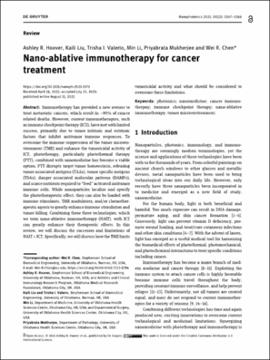| dc.contributor.author | Hoover, Ashley R. | |
| dc.contributor.author | Liu, Kaili | |
| dc.contributor.author | Valerio, Trisha I. | |
| dc.contributor.author | Mukherjee, Priyabrata | |
| dc.contributor.author | Chen, Wei R. | |
| dc.date.accessioned | 2021-12-21T16:23:03Z | |
| dc.date.available | 2021-12-21T16:23:03Z | |
| dc.date.issued | 2021-08-11 | |
| dc.identifier.citation | Hoover, Ashley R., Liu, Kaili, Valerio, Trisha I., Li, Min, Mukherjee, Priyabrata and Chen, Wei R.. "Nano-ablative immunotherapy for cancer treatment" Nanophotonics, vol. 10, no. 12, 2021, pp. 3247-3266. https://doi.org/10.1515/nanoph-2021-0171 | en_US |
| dc.identifier.uri | https://hdl.handle.net/11244/332543 | |
| dc.description.abstract | Immunotherapy has provided a new avenue to treat metastatic cancers, which result in ∼90% of cancer related deaths. However, current immunotherapies, such as immune checkpoint therapy (ICT), have met with limited success, primarily due to tumor intrinsic and extrinsic factors that inhibit antitumor immune responses. To overcome the immune suppression of the tumor microenvironment (TME) and enhance the tumoricidal activity of ICT, phototherapy, particularly photothermal therapy (PTT), combined with nanomedicine has become a viable option. PTT disrupts target tumor homeostasis, releasing tumor associated antigens (TAAs), tumor specific antigens (TSAs), danger associated molecular patterns (DAMPs), and scarce nutrients required to “feed” activated antitumor immune cells. While nanoparticles localize and specify the phototherapeutic effect, they can also be loaded with immune stimulants, TME modulators, and/or chemotherapeutic agents to greatly enhance immune stimulation and tumor killing. Combining these three technologies, which we term nano-ablative immunotherapy (NAIT), with ICT can greatly enhance their therapeutic effects. In this review, we will discuss the successes and limitations of NAIT + ICT. Specifically, we will discuss how the TME limits tumoricidal activity and what should be considered to overcome these limitations. | en_US |
| dc.description.sponsorship | This work was supported in part by grants R01CA205348 from the National Cancer Institution (doi.org/10.13039/100008569) and HR16-085 and HF20-019 from the Oklahoma Center for the Advancement of Science and Technology (doi.org/10.13039/100008569).
Open Access fees paid for in whole or in part by the University of Oklahoma Libraries. | en_US |
| dc.language | en_US | en_US |
| dc.rights | Attribution 4.0 International | * |
| dc.rights.uri | https://creativecommons.org/licenses/by/4.0/ | * |
| dc.subject | Photonics | en_US |
| dc.subject | Nanomedicine | en_US |
| dc.subject | Cancer immunotherapy | en_US |
| dc.subject | Immune checkpoint therapy | en_US |
| dc.subject | Nano-ablative immunotherapy | en_US |
| dc.subject | Tumor microenvironment | en_US |
| dc.title | Nano-ablative immunotherapy for cancer treatment | en_US |
| dc.type | Article | en_US |
| dc.description.peerreview | Yes | en_US |
| dc.identifier.doi | 10.1515/nanoph-2021-0171 | en_US |
| ou.group | Gallogly College of Engineering::Stephenson School of Biomedical Engineering | en_US |

